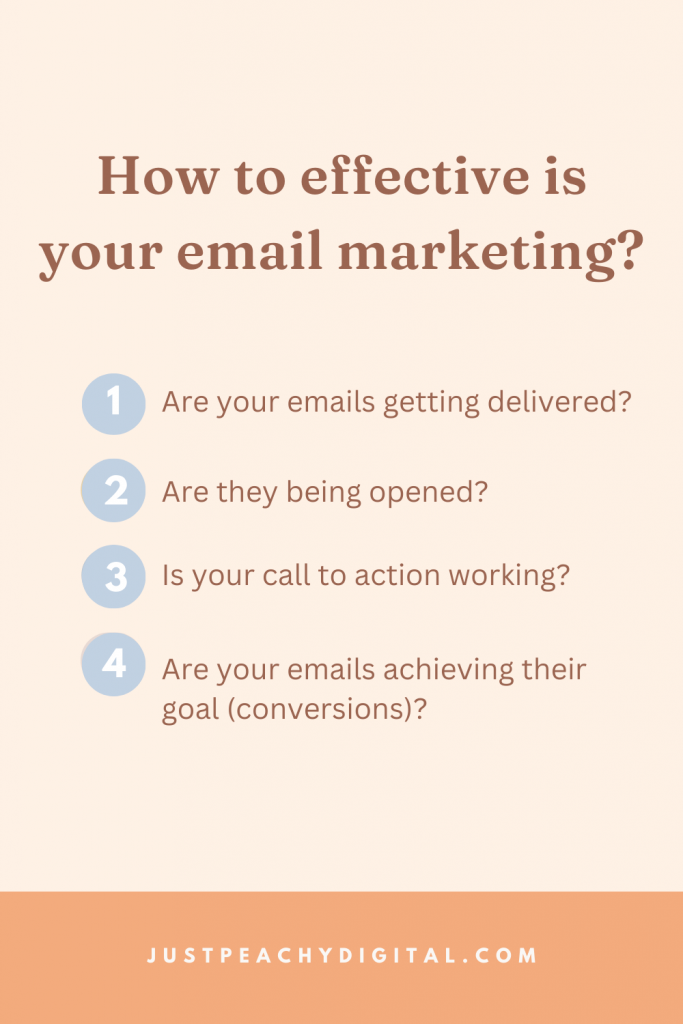Email marketing for beginners: strategy, content ideas & metrics

Ever wondered why email marketing is such a big deal? I’m here to share a few (very convincing) reasons why I think you should make it a priority for your business. From building lasting connections with your audience to delivering impressive ROI, email is a game-changer for marketing your small business.
But it’s not just about having an email list; it’s about sending the right content to keep your subscribers hooked. I’ll share some exciting ideas and strategies to keep your emails engaging and relevant. Plus, I’ll break down the key metrics you need to know to ensure your emails are reaching, resonating, and driving action. Let’s get into the basics of email marketing for beginners…
Why should you care about email marketing?
- The return on investment is unmatched: I’m sure you’ve heard this stat before: the average return on investment for email marketing is around $42 for every $1 spent! So of all your marketing channels, it’s the one that’s worth putting your time, energy and money into.
- The game-changing personalisation: One of the HUGE perks of email marketing is being able to segment your audience based on things like preferences, past behavior, or purchase history. This means you can send relevant and personalised emails to your audience leading to better engagement.
- It helps build customer engagement and retention: Email is an incredible tool for engaging with existing customers, nurturing leads, and building long-term relationships. Regular emails can help your business stay top-of-mind with your audience.
WHAT SHOULD YOU SEND YOUR EMAIL LIST?
This tends to be the biggest hurdle business owners face when it comes to email marketing. But don’t worry, here’s a good place to start. Check out my blog post which covers 10 things you can send your email list that they will actually enjoy.

Email marketing for beginners | 4 metrics you need to know
Deliverability:
How many people are actually receiving the emails you send?
Email deliverability measures whether your emails are successfully delivered to the recipients’ primary email folders rather than being filtered into spam or junk folders, or being blocked altogether by email service providers (that would be gmail, outlook, hotmail etc).
Why is deliverability important?
We’re after high email deliverability because if our emails are actually reaching our subscribes, it’s more likely that they’ll be opened, read, and engaged with.
What impacts deliverability?
- Sender Reputation: Internet Service Providers use sender reputation as a major factor in determining whether to deliver your emails to the inbox, the spam folder, or to block them altogether.
- Authentication Protocols: this helps Internet Service Providers verify that your emails are legitimately sent from your domain and not forged.
- Email Content: this includes subject lines, body text, and attachments. Spammy content, excessive use of certain words (like “free,” “urgent,” etc.), and misleading subject lines can trigger spam filters and decrease deliverability.
- List Quality and Compliance: Sending emails to outdated, purchased, or unsegmented lists with inactive or incorrect email addresses can increase bounce rates and trigger spam filters.
How to fix your deliverability?
- Activate double opt-in: this adds an extra safety step to the subscription process which requires people to verify their email address and confirm they’re interested.
- Only send emails to people who have given you permission!
- Ensure you comply with regulations by: having a clear option to unsubscribe, including a physical address, and honoring unsubscribe requests.
- Regularly clean your email list to remove any inactive subscribers.

Open rate:
Of the people that receive your emails, how many people are opening your emails?
Email open rate is the percentage of people who open an email out of the total number of emails delivered.
If you’re a numbers person, the formula looks like this: Open Rate = (Number of Unique Opens / Number of Emails Delivered) ×100
Why is open rate important?
Once an email has been successfully delivered to one of your subscribers, the next hurdle is getting them to open it! By tracking your open rate, you can be aware of which emails are and aren’t being read and switch up your strategy to improve that.
What impacts email open rates?
- Subject Line and Preview text: The subject line and preview text are the first things someone sees when they receive your email. An interesting or intriguing subject line can grab their attention and entice them to open the email.
- Sender Name: Emails from recognisable and trusted senders are more likely to be opened.
- Email Timing and Frequency: Sending emails at times when your audience is most likely to be checking their inbox can increase the likelihood of them being opened. Sending too many emails may be annoying, leading to lower open rates.
- List Segmentation: Segmenting your email list based on demographics, preferences, past interactions, or purchasing behavior allows you to send targeted and relevant content to different groups within your audience.
How to fix email open rate?
- Test email subject lines to figure out which get the best engagement.
- Use a sender name that people will recognise and trust, such as your brand name or a person associated with your business.
- Experiment with different send times to determine when your audience is most engaged.
- Segment your audience so you can send highly relevant emails to them.

Click-through rate:
How many people are clicking on links in your emails?
Email click-through rate (CTR) is the percentage of people who click on a link/s within an email out of the total number of emails delivered.
For my numbers people, here’s the formula for this one: CTR = (Number of Unique Clicks / Number of Emails Delivered) ×100
Why is click-through rate important?
Generally, the purpose behind sending emails to your audience is to get them to take a particular action. Whether that’s reading a new blog post, filling out a feedback form or buying a product.
Your click-through rate provides insights into how effective your emails are at encouraging that engagement.
What impacts email click-through rate?
- Relevance of Content: How relevant your email content is to your audience’s interests, needs, and preferences.
- A Compelling Call-to-Action: A clear and compelling call to action (CTA) encourages people to take the desired action. The placement and visibility of links and CTAs within your email can also affect click-through rates.
- Email Design and Formatting.
- Personalisation and Segmentation: Personalising your content and segmenting your email list based on demographics, preferences, or past behavior can increase relevance and engagement, leading to higher CTR.
How to fix email click-through rate?
- Ensure that your email content, including subject lines, body text, and CTAs, will resonate with your subscribers and provide value to them.
- Use actionable language and large buttons to make CTAs stand out.
- Position CTAs prominently within the email, ideally above the fold (so it’s visible without scrolling) to make it easy for people to click.
- Make your email design visually appealing by keeping content concise and scannable. And ensure your emails are mobile-responsive.
- Tailor your messaging and offers to specific segments to deliver relevant content.

Conversion rate:
Of the people that click through, how many take the desired action?
Email conversion rate is the percentage of people who complete a desired action, such as making a purchase, signing up for a webinar, downloading a resource, or filling out a form, after clicking on a link within an email.
The formula for email conversion rate is: Conversion Rate = (Number of Conversions/Number of Emails Delivered) ×100
Why is conversion rate important?
It’s the best indication of how effective all of your email marketing efforts are.
What impacts email conversion rates?
- Relevance of your Offer: Make sure that your offer aligns with your audience’s needs, interests, and pain points.
- Social Proof: Incorporating social proof, such as customer reviews, ratings, or user-generated content, helps to build credibility and trust.
- Urgency and Scarcity: Creating a sense of urgency or scarcity in your email messaging can motivate recipients to act quickly and increase conversion rates.
- Follow-Up and Remarketing: Implement follow-up and remarketing strategies to re-engage recipients who have shown interest but haven’t converted yet.
How to fix conversion rates?
- Share positive experiences and testimonials from your customers.
- Use limited-time offers, countdown timers, or exclusive deals to encourage people to take action now.
- Send follow-up emails to remind people of your offer.
- Clearly communicate the benefits and value of your offer.
- Experiment with different elements of your emails, such as subject lines, CTAs, offers, and design, to figure out what resonates with your audience and increases conversions.
Looking for support with your email marketing?
Whether it’s a content plan for you to implement or taking content creation off your plate entirely, I can help you with that!
Let’s create valuable, engaging email newsletters that your audience will actually open and enjoy. I can help you make the most of your email marketing and get the opens and sales that you’re hoping for.
